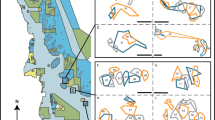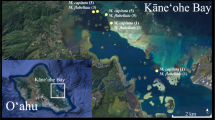Synopsis
In the Gulf of Aqaba Dascyllus aruanus and D. marginatus, form distinct populations organised into harems of single males and groups of females, living permanently in Stylophora and Acropora corals. Each harem consists of 4 sexual casts: dominating males, adult females, sex-changing fish and juveniles. The sexual performance of each adult fish in such social units is controlled by the presence or absence of a dominating male. In corals occupied by mixed groups of both species, only those females spawn that belong to the same species as the dominating male. Direct observation in the sea shows that such situations are produced by indiscriminative settling mechanisms of groups of juvenile fish. Evidence is also presented, demonstrating that dispersion of coral colonies suitable for occupancy and predation by piscivorous fish can modulate such complicated reproduction.
Similar content being viewed by others
References cited
Atz, Y.W. 1964. Intersexuality in fishes. pp. 149–232. In: C.N. Armstrong & A.J. Marshall (ed.) Intersexuality in Vertebrates, Including Man, Academic Press, New York.
Avidor, A. 1976. The signal jump and its associated sound in fish of the genus Dascyllus (Pomacentridae) from the Gulf of Elat. M.Sc. Thesis, Tel Aviv University, Tel Aviv. 63 pp.
Dawkins, R. & T.R. Carlisle. 1976. Parental investment, mate desertion and a fallacy. Nature 262: 131–133.
Fishelson, L. 1964. Observation on the biology and behaviour of Red Sea coral fishes. Bull. Sea Fish Res. St. Haifa 37: 11–26.
Fishelson, L. 1970. Protogynous sex-reversal in the fish Anthias squamipinnis (Teleostei, Anthiidae) regulated by the presence or absence of a male fish. Nature 227: 90.
Fishelson, L. 1975. Ecology and physiology of sex-reversal in the fish Anthias squamipinnis (Peters) (Teleostei: Anthiidae). pp. 284–294. In: R. Reinboth (ed.) Intersexuality in the Animal Kingdom, Springer Verlag, Berlin.
Fishelson, L. 1980. Partitioning and sharing of space and food resources by fish. pp. 415–445. In: J.E. Bardach, J.J. Magnuson, R.C. May & J.M. Reinhart (ed.) Fish Behavior and Its Use in the Capture and Culture of Fishes, ICLARM Conference Proceedings 5, Manila.
Fishelson, L., D. Popper & A. Avidor. 1974. Biosociology and ecology of pomacentrid fishes around the Sinai Peninsula. J. Fish Biol. 6: 110–133.
Fricke, H.W. 1975. Evolution of social systems through site attachment in fish. Z. Tierpsychol. 39: 206–211.
Fricke, H.W. 1977. Community structure, social organisation and ecological requirements of coral reef fish (Pomacentridae). Helgoländer wiss. Meeresunters. 30: 412–426.
Fricke, H.W. 1980. Control of different mating systems in a coral reef fish by one environmental factor. Anim. Behav. 28: 561–569.
Gunderman, N. 1972. Reproductive cycle and sex-inversion in Anthias squamipinnis (Peters). M. Sc. Thesis, Department of Zoology, Tel Aviv University, Tel Aviv. 109 pp. (In Hebrew).
Hobson, E.S. 1978. Aggregating as a defense against predation in aquatic and terrestrial environments. pp. 219–234. In: E.S. Rees & F.J. Lighter (ed.) Contrasts in Behaviour, John Wiley & Sons, Chichester.
Holzberg, V.S. 1973. Beobachtungen zur Ökologie und zum Sozialverhalten des Korallenbarsches Dascyllus marginatus Rüppell (Pisces: Pomacentridae). Z. Tierpsychol. 33: 492–513.
Katzir, G. 1976. Visual elements in the sex differentiation of Dascyllus auranus (Pomacentridae). M.Sc. Thesis, Hebrew University of Jerusalem, Jerusalem. 140 pp.
Kinne, O. 1977. Marine ecology, Vol. 3, Cultivation. John Wiley & Sons, Chichester. 714 pp.
Loiselle, P.V. & G.W. Barlow. 1978. Do fish lek like birds? pp. 31–74. In: E.S. Reese & F.J. Lighter (ed.) Contrasts In Behavior, John Wiley & Sons, Chichester.
Moyer, J.T. & L.J. Bell. 1976. Reproductive behavior in the anemonefish Amphiprion clarkii at Miyakje-lima, Japan. Japan J. Ichthyolol 23: 23–32.
Myrberg, A.A. & R.E. Thresher. 1974. Interspecific aggression and its relevance to the concept of territoriality in reef fish. Amer. Zool. 14: 81–96.
Popper, D. & L. Fishelson. 1973. Ecology and behaviour of Anthias squamipinnis (Anthiidae, Teleostei) in the coral habitat of Eilat (Red Sea). J. exp. Zool. 184: 409–424.
Reinboth, R. (ed.) 1975. Intersexuality in the Animal Kingdom. Springer Verlag, Berlin. 449 pp.
Robertson, D.R. 1972. Social control of sex-reversal in a coral reef fish. Science 177: 1007–1009.
Robertson, D.R. 1974. The ethology and reproduction biology of Labroides dimidiatus. Ph.D. Dissertation, University of Queensland, St. Lucia. 293 pp.
Robertson, D.R. & B. Lassig. 1980. Spatial distribution patterns and the coexistence of a group of territorial damsel fish from the Great Barrier Reef. Bull. Mar. Sci. 30: 187–203.
Sale, P.F. 1972. Influence of corals on the dispersion of the pomacentric fish, Dascyllus aruanus. Ecology 53: 741–744.
Sale, P.F. 1975 Mechanisms of co-existence in a guild of territorial reef fish. Mar. Biol. 29: 89–97.
Sale, P.F. 1978a. Coexistence of coral reef fishes — a lottery for living space. Env. Biol. Fish. 3: 85–102.
Sale, P.F. 1978b. Reef fishes and other vertebrates: a comparison of social structures. pp. 313–346. In: E.S. Reese & F.J. Lighter (ed.) Contrasts in Behavior, John Wiley & Sons, Chichester.
Sale, P.F. & R. Dybdahl 1978. Determinants of community structure for coral reef fish in isolated coral heads at lagoonal and reef slope sites. Oecologia 34: 57–74.
Sale, P.F., A.D. William & P.J. Doherty. 1984. Choice of microhabitats by coral reef fishes at settlement. Coral Reefs 3: 91–99.
Shapiro, D.Y. 1984. Sex reversal and sociodemographic processes. pp. 103–117. In: G.W. Potts & R.J. Weston (ed.) Fish Reproduction, Academic Press, London.
Shapiro, D.Y. & R. Lubbock. 1980. Group sex ratio and sex reversal. J. Theor. Biol. 82: 411–426.
Shpigel, M. 1978. The spatial heterogeneity in branching corals and fish species diversity. M.Sc. Thesis, Tel Aviv University, Tel Aviv. 80 pp.
Shpigel, M. 1982. Niche overlap among two species of coral dwelling fishes of the genus Dascyllus (Pomacentridae). Env. Biol. Fish. 7: 65–68.
Smith, C.L. & J.C. Tyler. 1972. Space resource sharing in a coral reef fish community. pp. 125–170. In: B.B. Collete & S.A. Earle (ed.) Results of the Tektite Program: Ecology of Coral Reef Fishes, Bull. Nat. Hist. Mus. Los Angeles County 14, Los Angeles.
Smith, C.L. 1975. The evolution of hermaphroditism in fishes. pp. 295–350. In: R. Reinboth (ed.) Intersexuality in the Animal Kingdom, Springer Verlag, Berlin.
Sweatman, H.P.A. 1983. Influence of conspecific on choice of settlement sites by larvae of two pomacentrid fishes (Dascyllus aruanus and D. reticulatus) on coral reefs. Mar. Biol. 75: 225–229.
Thresher, R.E. 1976. Field analysis of the territoriality of the threespot damsel fish Eupomacentrus planifrons (Pomacentridae Copeia 1976: 266–276.
Thresher, R.E. 1977. Ecological determinants of social organisation of reef fishes. Proc. 3rd Int. Symp. Coral Reef 1: 551–557.
Warner, R.R. 1978. The evolution of hermaphroditism and unisexuality in aquatic and terrestrial animals. pp. 77–101. In: E.S. Reese & F.J. Lighter (ed.) Contrasts in Behavior, John Wiley & Sons, Chichester.
Author information
Authors and Affiliations
Rights and permissions
About this article
Cite this article
Shpigel, M., Fishelson, L. Behavior and physiology of coexistence in two species of Dascyllus (Pomacentridae, Teleostei). Environ Biol Fish 17, 253–265 (1986). https://doi.org/10.1007/BF00001492
Received:
Accepted:
Issue Date:
DOI: https://doi.org/10.1007/BF00001492




